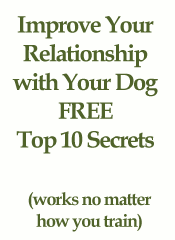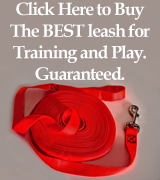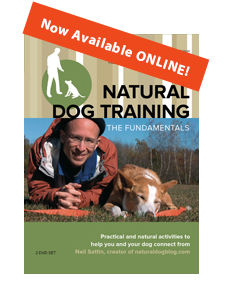When your dog is aggressive towards other dogs, remember that what you're really dealing with is a dog who can't stay relaxed around other dogs. That's the problem, period. A dog who can't stay relaxed around other dogs will reach the point of overload, resulting in dysfunctional behavior of some sort. So our goal, in Natural Dog Training, is to help teach a dog how to stay relaxed as they experience higher and higher levels of stimulation. Up until now, all of the how-to-deal-with-aggression techniques that we've talked about have been aimed at this goal. Depending on just how deep the "charge" in your dog is, you might be covered with the techniques we've already discussed. However, for a dog with aggression issues closer to the core, you will need a method to help change the way your dog experiences another dog at the moments when the situation gets most tense - just before, during, and after a "fight".
IMPORTANT INFORMATION: Dogs are creatures with very sharp teeth, and when you're working with dogs, especially an aggressive dog, you run the risk of getting bitten. YOU ARE MAKING THE CHOICE to use these techniques AT YOUR OWN RISK! Be careful and take precautions! If you're nervous, take time to relax yourself. If you feel like you're in over your head, then seek a dog professional to help you.
EVEN MORE IMPORTANT INFORMATION: As I mentioned in the title of this article, this is an ADVANCED technique. Before you attempt the technique that I am about to describe, you need to understand and have mastered the techniques in the following articles (you'll recognize the descriptions from my Learn the Basics section). Take your time - there's no reason to rush the process. It is BETTER to go too slow than to try to go too fast. I am available if you have any questions about any of these articles - feel free to contact me through my contact page:
One last thing - you're going to need a partner with a dog to do this exercise. If you've been waiting to tell some of your best dog-owning friends about this site - now's your chance! 🙂 Make sure that your partner (and your partner's dog) have familiarity with the following articles/exercises as well. The best thing would be if your dog tends to act aggressively toward your partner's dog. The dogs will be kept separated from each other throughout the exercise, so they'll be safe from each other.
- What is Natural Dog Training anyway? This should have been the article that kicked off the whole blog - instead it came later, and it's meant to be a summary of what Natural Dog Training is and why it's so great for ensuring you have the "happiest dog on the block".
- Play Tug of War with Your Dog, Let Your Dog Win, and Have the Happiest Dog on the Block. Tug-of-war is one of the most fundamental tools you have for becoming the center of your dog's universe. In this article I talk about the right way to play, why you SHOULD let your dog win (every time), and how to keep your dog coming back for more.
- What it truly means to be "calm" and "assertive" - Be the Moose in your dog's life. At the center of Natural Dog Training is the knowledge that our dogs are at their most focused, engaged, and SOCIAL when you tap into their prey drive. This article explains how the prey/predator dynamic is at work in your dog's life, and why it's important to be the moose - NOT the "alpha".
- Understanding how your dog feels the world. This article gets at the heart of our dogs' emotional experience of the world around them. You will learn about how a dog's emotions are at the root of all of their behavior, and how "problems" are really simply a matter of a dog's inability to physically relax at high levels of stimulation. You will have a fresh look at the way that your dog experiences the world, which is way more about the way they feel than it is about the way they think.
- How to Relax Your Dog. In order to teach your dog what to do when they're energized, FIRST you have to know how to relax your dog. This article teaches you specific techniques for relaxing your dog. It also will reveal to you some things that you might be doing with your dog that are...counterproductive.
- Using a REALLY long leash when you train your dog. We all want a dog who will behave perfectly when they're off-leash. The best way to teach your dog how to be off-leash is to give them the feeling of being off-leash to begin with! This article talks about the benefits of using a really long training lead. I also sell leads that are 50 feet long and made of one-inch wide nylon, in case you're having trouble finding a quality lead locally.
- Developing the Right Attitude as a dog trainer. Training your dog can be tough at times. It's an emotional experience for your dog, and it's an emotional experience for you. This article talks about how to stay positive, and how to see your dog's "problems" as opportunities for learning.
- How to "push" with your dog to tap into their primal prey drive and overcome their resistance to you. Pushing is at the core of introducing your dog to Natural Dog Training, so this is a lesson that you should NOT miss. With this technique you will learn how to attract your dog during their most energized moments, and you will learn how to resolve the most important question your dog is asking you: What do I do with my energy?
- Why pushing works - an explanation. This article describes why pushing works, and offers some additional insight into the process of resolving your dog's stress.
- What is dog aggression and how do I stop it? If you really want to understand why a dog is aggressive and you truly want to overcome this problem, this article is a must read. I explain how the way a dog feels the world turns into aggressive behavior, and give you some introductory ways to help an aggressive dog become a formerly-known-as-aggressive dog.
- How to introduce your dog to another dog. In this article you will learn the best way to introduce two dogs to each other, in order to nip any potential problems in the bud.
- How to REDIRECT an excited or aggressive dog. Now we're really getting into the heart of how to apply your Natural Dog Training skills. This article shows you how you can redirect the energy going into that squirrel, person, dog, car, etc. when you're out on a walk with your dog - and to teach that dog to give YOU that energy, since that's where it truly belongs. Want your dog to look to you for an answer when they see the thing that triggers them? One of your fundamental techniques is here.
NEW STUFF BEGINS HERE:
Thanks for sticking with me through all of the preliminary stuff. I want you to experience success with Natural Dog Training, and the only way to do that (safely) is for you to take your time and get comfortable with the methodology.
Next step is for you to locate a place to work with your partner. You need to find a place with a chain-link fence where there is room to run on either side of the fence. I've found that athletic fields (as long as no one else is around) are a great place to work. There should be grass on either side of the fence, and it (the fence, not the grass) should be at least 50 feet in length - longer is better. This fence is going to allow the two dogs to see each other, interact with each other, perhaps even act aggressively towards each other - without any risk of contact.
Once you've found the right spot, you and your partner should both be wearing clothing that protects your body, but that also allows you to run (you'll might even want your running shoes for this one). You should have your dogs leashed (with a flat collar) - and you should hold your end of the leash AT ALL TIMES. If there's tension between the two of them you should keep them separated. It's helpful if the dogs are a little hungry, too - so consider skipping a meal before you head out to do the exercise. With some ultra-tasty food in your food pouch, your dogs' favorite tug toys, and your location-with-a-fence, you're ready to go. I'm going to describe the exercise to "you" - but your partner should essentially be doing the same thing with their dog as you step through the technique.
- Have the dogs on opposite sides of the fence. Can't stress this enough - you're keeping the dogs from actually being able to have any physical contact with each other.
- Stand about 10 feet away from the fence with your dog. This is to help your dog be focused on you during the initial moments, and to build up the attraction between the two dogs.
- Do a little pushing with your dog. Doing the pushing will help get the dog's energy flowing. Remember that you are teaching your dog how to RELAX at high levels of stimulation, and pushing is the key to being able to do that.
- After you've done that for a minute or two, approach the fence. Encourage the dogs to "get" each other. You actually WANT to see some "aggression" at this point, but don't force it. In between telling your dog to "get" that other dog, you should be praising your dog. Think of it not as encouraging the dogs to fight, but actually allowing your dog to express some of the pent-up stress that's within them. You are taking your dog right up to the point where they feel the most vulnerable, so they will need your reassurance that everything is OK in their world as they experience the overload (aggressive) behavior. So saying "good dog, get that dog" is really like saying "Good dog, it's ok with me for you to feel the way you feel. We'll deal with it together."
- Let the dogs snarl at each other right at the fence - it can look pretty nasty at times. At a lull in the excitement, start backing away from the fence, give your dog a "Ready!" to get their attention, then call your dog's name and do some more pushing. Remember how as you push you are always moving backwards, away from your dog, to encourage your dog to come towards you? Well, you should be moving backwards away from the fence as well.
- Push for a few seconds, then give your dog another "Ready!". Now start running! You are going to run along the fence with your dog. Run 50-75 feet in one direction, then change directions and run back to where you started. Run in the other direction once more - and once again back to where you started. That's 2 "laps" (back and forth twice). During the whole time, you can let your dogs get as close to the fence as they want to go. They might interact with each other, they might growl/bark - everything is FINE as long as you keep running.
- When you get back to where you started (after you've finished your laps), take a moment to catch your breath. This is important - no heart attacks, please! The dogs might be ok to sniff around each other at the fence at this point. Just try to keep it relaxed for the time being. Give it a minute or two.
- Time to start again. The whole cycle will look like this: Do some pushing. Encourage the dogs to "fight" at the fence. Push again for a minute. Then run your laps again. Rest at the starting place.
- If you have trouble getting the dogs to get aggressive at the fence (it will become progressively more difficult), you can try playing tug with ONE of the dogs right at the fence. The additional energy of the toy and tug-of-war being added to the mix should help take things up a notch.
After you've repeated the cycle six times or so, you probably won't be able to get the dogs interested in each other at the fence anymore. You also will probably be getting tired yourself. At this point, do a little more pushing with your dog, then let your dog have some water. If you have a single (large) water bowl, you could try getting the dogs to alternate taking drinks from the bowl - just make sure that each dog is COMPLETELY CLEAR of the bowl before you let the other dog in for a drink. YOU DO NOT WANT THE DOGS TO FIGHT AT THIS POINT!
Now, just because the dogs won't fight at the fence anymore doesn't mean that anyone is cured. It also doesn't mean that they won't fight at the fence tomorrow. My point is that you should still be cautious with the two dogs, not expecting them to play with each other just yet.
Going back through what we know about dog emotion, what is this exercise teaching your dog? It's like the analogy of the "race car driver" in my article on understanding how your dog feels the world - you are allowing your dog to get right up to "racing speeds" (by allowing the fence fighting) - and you are giving your dog a positive outlet for the energy that they're experiencing through the pushing (which directs the energy at you) and the running (which helps them get the tension out of their bodies). Additionally the parallel running helps the dogs synch up their energy - it's a healthy way for THEM to work out the emotional energy that is being exhanged. In fact, the running at the fence allows the dogs to engage with each other in a way that's very similar to the "play" of two friendly dogs - so you're also building your dog's social skills in the process.
Once you've done this exercise several times with your dog, you will probably find that your dog can handle encounters with strange dogs (on-leash, please!) a bit more easily, and you might be able to navigate the on-walk introductions that I described in this article on how to introduce two dogs to each other. As your dog becomes more clear in showing "play" signals around other dogs, you can probably give your dog a little more latitude to interact freely. When you do, it's important to quit while you're ahead (in other words, let the dogs play a little bit - then separate them and do some pushing/tug with your dog to help resolve any stress the situation created) - and make sure that you always use a long lead so that you can separate your dog from an altercation in case one occurs.
The more you help your dog relax in these situations, the more that you will notice subtle changes in how your dog navigates social interactions with other dogs. When they would formerly have been aggressive immediately, you'll notice that your dog will give warning barks to other dogs that encroach to rapidly - and if those dogs keep their distance, you'll be able to step in to help your dog relax in the moment. The warning bark is a sign of PROGRESS - so keep praising your dog and stay focused on the overall task of "helping your dog relax" when energized.
Your dog will probably begin to look to you for resolution in these moments, since your work with pushing and redirection reinforces that what it feels like to "interact with another dog" is to play with you (pushing, tug of war, etc.). Should that happen, take advantage of the opportunity to resolve any stress your dog is feeling. The most important part is resolving that energy - the aggression-less dog interactions will come with time. Stay relaxed, take it slow, and maintain your awareness of what's happening with your dog (and within yourself) in the moment. You'll get there with your dog as long as you stay patient and allow the process to unfold naturally, at its own pace. In the meantime, keep me posted on your progress, and let me know if you have any questions.





Trackbacks/Pingbacks